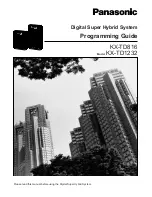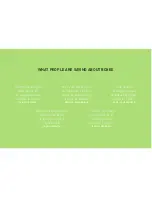
7 APPLICATION INSTRUCTIONS
7.8 String Processing Instructions
649
7
■
Operation of when SM705 (Number of conversion digits selection) is on
Decimal ASCII data is stored right-justified in (d).
The following figures show an example of a value of (s) and a value stored in (d).
• When the number of operation digits is less than the maximum number of digits (a sign + 10 digits), 00H is stored in the end
of the string regardless of the status (on/off) of SM701 (Number of output characters selection). If the end of the string is the
lower byte, 00H is also stored in the upper byte.
• When the number of operation digits is equal to the maximum number of digits (a sign + 10 digits), 00H is stored in the
upper byte of (d)+5 if SM701 is off. 20H (space) is stored in the upper byte of (d)+5 if SM701 is on.
Operation error
There is no operation error.
Value of (s)
Data of (d) to (d)+2
Value of (s)
Data of (d) to (d)+2
• 0
• Positive value (1
digit in numeric
part)
• The upper byte of (d) is filled with 00H.
• (d)+1 and later remain unchanged.
• Positive value (2
digits in numeric
part)
• Negative value (1
digit in numeric
part)
• (d)+1 is filled with 00H.
• (d)+2 and later remain unchanged.
• Positive value (9
digits in numeric
part)
• Negative value (8
digits in numeric
part)
• The upper byte of (d)+4 is filled with 00H.
• (d)+5 and later remain unchanged.
• Positive value (10
digits in numeric
part)
• Negative value (9
digits in numeric
part)
• (d)+5 is filled with 00H.
• Negative value (10
digits in numeric
part)
• 00H is stored in the upper byte (1) of (d)+5 when
SM701 (Number of output characters selection) is
off, and 20H (space) is stored when it is on.
ASCII 10
9
: Billions place of ASCII code
ASCII 10
8
: Hundred-millions place of ASCII code
ASCII 10
1
: Tens place of ASCII code
ASCII 10
0
: Ones place of ASCII code
(d)+1
(d)+2
(d)+3
(d)+4
(d)+5
(d)
b15
b0
∙∙∙
∙∙∙
b7
b8
00H
ASCII 10
0
(d)+1
(d)+2
(d)+3
(d)
b15
b0
∙∙∙
∙∙∙
b7
b8
ASCII 10
1
/ 2DH (-)
00H
ASCII 10
0
(d)+4
(d)+5
(d)+1
(d)+2
(d)+3
(d)+4
(d)+5
(d)
b15
b0
∙∙∙
∙∙∙
b7
b8
ASCII 10
7
ASCII 10
5
ASCII 10
8
/ 2DH (-)
ASCII 10
6
ASCII 10
3
ASCII 10
4
ASCII 10
1
ASCII 10
2
00H
ASCII 10
0
(d)+1
(d)+2
(d)+3
(d)
b15
b0
∙∙∙
∙∙∙
b7
b8
ASCII 10
7
ASCII 10
5
ASCII 10
9
/ 2DH (-)
ASCII 10
8
ASCII 10
6
ASCII 10
3
ASCII 10
4
ASCII 10
1
ASCII 10
2
00H
ASCII 10
0
(d)+4
(d)+5
(d)+1
(d)+2
(d)+3
(d)
b15
b0
∙∙∙
∙∙∙
b7
b8
ASCII 10
9
ASCII 10
7
ASCII 10
5
2DH (-)
ASCII 10
8
ASCII 10
6
ASCII 10
3
ASCII 10
4
ASCII 10
1
ASCII 10
2
00H / 20H
ASCII 10
0
(1)
(d)+4
(d)+5
Summary of Contents for MELSEC iQ-R Series
Page 1: ...MELSEC iQ R Programming Manual Instructions Standard Functions Function Blocks ...
Page 2: ......
Page 24: ...22 INDEX 2092 INSTRUCTION INDEX 2093 REVISIONS 2104 WARRANTY 2105 TRADEMARKS 2106 ...
Page 34: ...32 MEMO ...
Page 35: ...33 PART 1 PART 1 OVERVIEW This part consists of the following chapter 1 OVERVIEW ...
Page 68: ...66 1 OVERVIEW 1 5 Precautions on Programming MEMO ...
Page 1448: ...1446 14 REDUNDANT SYSTEM INSTRUCTIONS 14 2 Disabling Enabling System Switching MEMO ...
Page 1972: ...1970 33 TIME DATA TYPE FUNCTIONS 33 4 Division MEMO ...
Page 2067: ...APPX Appendix 5 PID Control Program Examples 2065 A 252 Set PID control data for loop 2 ...
Page 2109: ......
















































